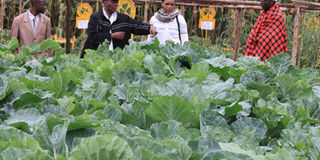Ask your Agronomist: Get the basic rules on fertiliser application

Show goers admire healthy vegetables at a past ASK show. A complete nutritional programme takes into account that to sustain yield for some time, it would be necessary to apply more fertiliser or nutrients than what is removed with harvest to ensure continued supply of nutrients. PHOTO | JOSEPH KANYI | NATION MEDIA GROUP
What you need to know:
- Acid pH of 4.5-5 limits the availability of nutrients and reduces cation exchange capacity.
- There are several factors to consider when using a fertiliser.
- Higher pH contributes to healthier roots, low incidences of diseases and higher yields.
Q : I am a young lady who wants to start farming, but I understand little about fertilisers. Please explain to me what influences the type of fertiliser to use, when and why?
Anne, Rongai
There are several factors that influence the type of fertiliser to use.
These are the type of soil, the crop you wish to grow and the weather of the location.
Soil
As you may know, soil is a reservoir of nutrients.
But those nutrients are either depleted or not readily available. This contributes to the type of soil pH you have. The pH is and can be affected by the following:-
- Use of inappropriate sources of fertiliser that may lead to soil acidification.
- Use of imbalanced nutritional programmes, which supply excess nutrients resulting to poor growth and yields.
- Applying fertilisers based on seasons, either when dry or rainy and not based on nutritional requirements of the crop.
Thus nutrients are not applied in the optimal moment thereby loosing effectivity.
- Applying of lower doses of fertiliser than necessary.
Acid pH of 4.5-5 limits the availability of nutrients and reduces cation exchange capacity.
Crop yield, root development and health improve with higher pH levels. Lower pH leads to malformed roots, low yields and high incidence of diseases.
Higher pH contributes to healthier roots, low incidences of diseases and higher yields.
Crop
There is need to understand the crop you wish to grow and it’s nutrient removal requirements that will influence maximum growth and yield.
There are several factors to consider when using a fertiliser. These are:-
a). Yield: Nutrient offtake during harvest.
b). Soil (fertility/pH/CEC): These determines the availability of nutrients in the soil.
c). Season: Loss of nutrients due to leaching during rainy seasons. Nutrients are not available during dry season.
d). Shadow: Lower yield potential on farms that have trees, thus lower nutrient requirement.
e). Biomass recycling: Input of nutrients from organic matter, that is, crop residues, compost, litter etc.
f). Plant growth (stem, branches and leaves): Nutrient fixation in the structure of the tree. A complete nutritional programme takes into account that to sustain yield for some time, it would be necessary to apply more fertiliser and/or nutrients than what is removed with harvest to ensure continued supply of nutrients.
For crop specific fertiliser recommendations, please consult the following agronomists in your area:
Central Region: Stephen Mburu 0728396204
Upper Rift Valley: Daniel Mui 0702466343.
Eastern: Dennis Nyandaya 0702466372.
Lower Rift Valley: Chris Masira 0798498320.
Western: Eric Okwado 0715484224.
Peter Wekesa, Senior Agronomist, Yara




